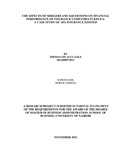| dc.description.abstract | An insurance company's primary objective is to restore the insured / policy holder back to the condition the insured was in before a loss and to spread risk through reinsurance. But at the back of it all, an insurance company's main role is to make a profit as they are a business. A merger is a combination of two or more companies in which the resulting firm maintains the identity of the firms, usually the larger. Companies merge for many reasons some of which are that they are worth more together than. Others do to cut costs through vertical integration where a company merges with either its supplier or consumer purposely to enable the resulting company to acquire raw materials at the marginal cost, others merge for growth and market power and to eliminate competition mainly through merging with a competitor to create more power in the market. Other companies merge to diversify, like acquiring another company in a seemingly unrelated industry in order to reduce the impact of a particular industry's performance on its profitability. According to “Africa Reinsurance Corporation 2011, Annual Reports and Accounts”, in the year 2011 was in many ways very bad for property / casualty insurers and reinsurers. Surprisingly, heavy catastrophe losses hit the industry even where they were not expected, in the previously called “cold spots”. It is believed that the earthquake and tsunami in Japan (above US$ 35billion incurred losses), the earthquake in New Zealand, the floods in Thailand and other natural perils caused over 30,000 deaths and US$350 billion total economic losses compared with US$226 billion in 2010. Insured catastrophe losses of above US$103 billion could be the costliest year for the industry. Regulation is also forcing new requirements of sophisticated risk management, possible capital increase and high compliance costs. Keeping up with the focus on growth with profitability and to grow premium income by a greater percentage across all business lines, effort to deal with claims expeditiously and pro-actively, to settle claims and outperform the market, make adequate provisions for outstanding claims, develop new products that are not only flexible but also targeted at the uninsured populace of the society whilst adding value, are part of challenges that engulf the insurance industry and its players.
The study set out to investigate the effects of Mergers and acquisition on the financial performance of insurance industry in Kenya. The study took a causal research design. Causal research design is consistent with the study objective which is to determine the effects of mergers on financial performance of insurance industry in Kenya which can be measured through long-run profitability, stability, leverage and liquidity. Gay and Airasian (2003) noted that causal research designs are used to determine the causal relationship between one variable and another. In this study, the population was insurance companies in Kenya with keen interest on those that have gone through mergers and acquisitions. The process of data collection involved the use of audited accounts used to estimate the relationship between pre and post merger, and liner regression model to enhance the analysis of the effects of M & A on financial performance. A paired t-test was performed to determine if a merger was effective. The mean profit before tax was 316.2, with standard deviation of 405.598 for 5 observations was significantly greater than zero, t(4)=1.74, two-tail p = 0.16, providing evidence that the merger is effective on the financial performance of the insurance company. A 95% confidence interval about mean weight loss is (187.42, 820.02). By carrying out regression tests, it was possible to confirm the relationship between mergers and financial performance where it was found out that the two have a strong relationship. However, the regression analysis could not be used exclusively since it was found out to be much lower than the residual figures hence confirming that financial performance of insurance companies were affected to a large extent (67%) by other factors other than mergers/acquisitions (33%). Based on the evidence collected from the study, as above, the researcher is for policy that insurance companies should opt for mergers / acquisitions to enable the insurer / reinsurer alleviate the above challenges among others that engross the insurance industry. | en |

